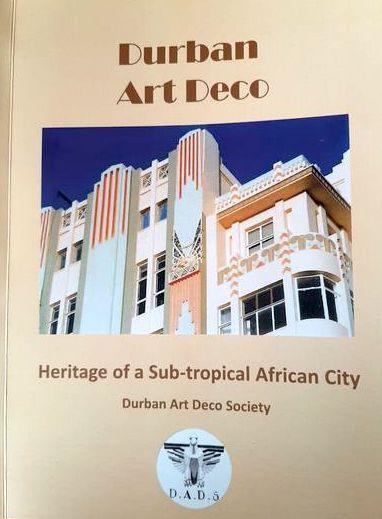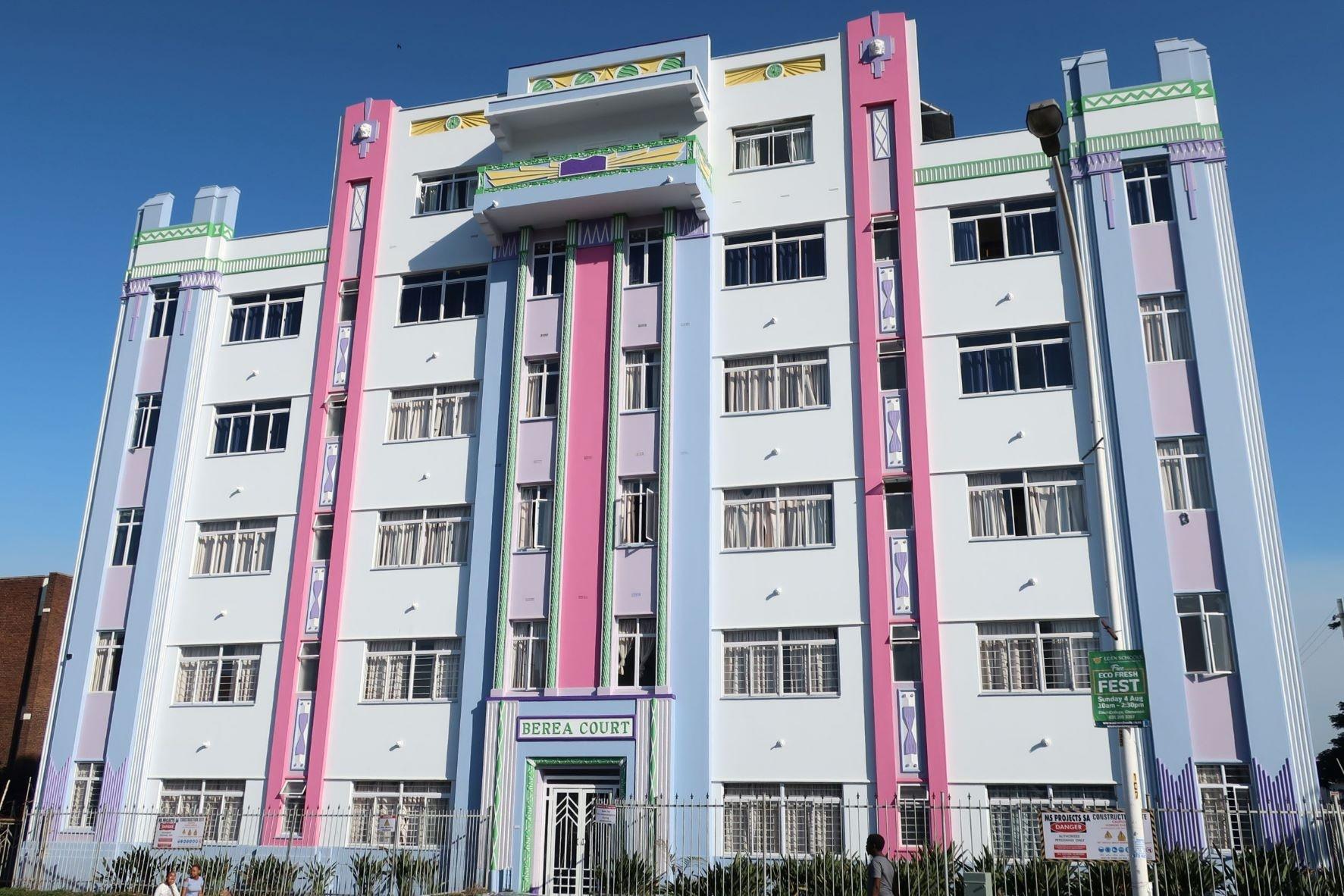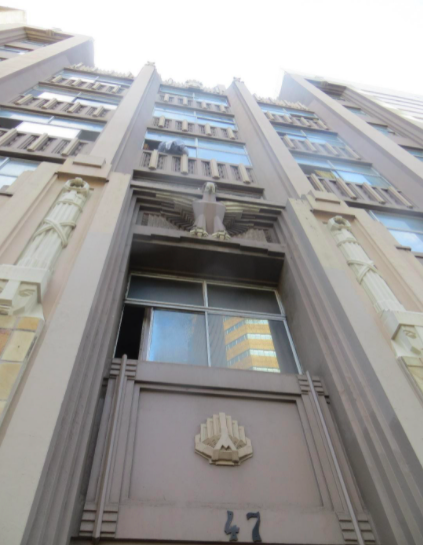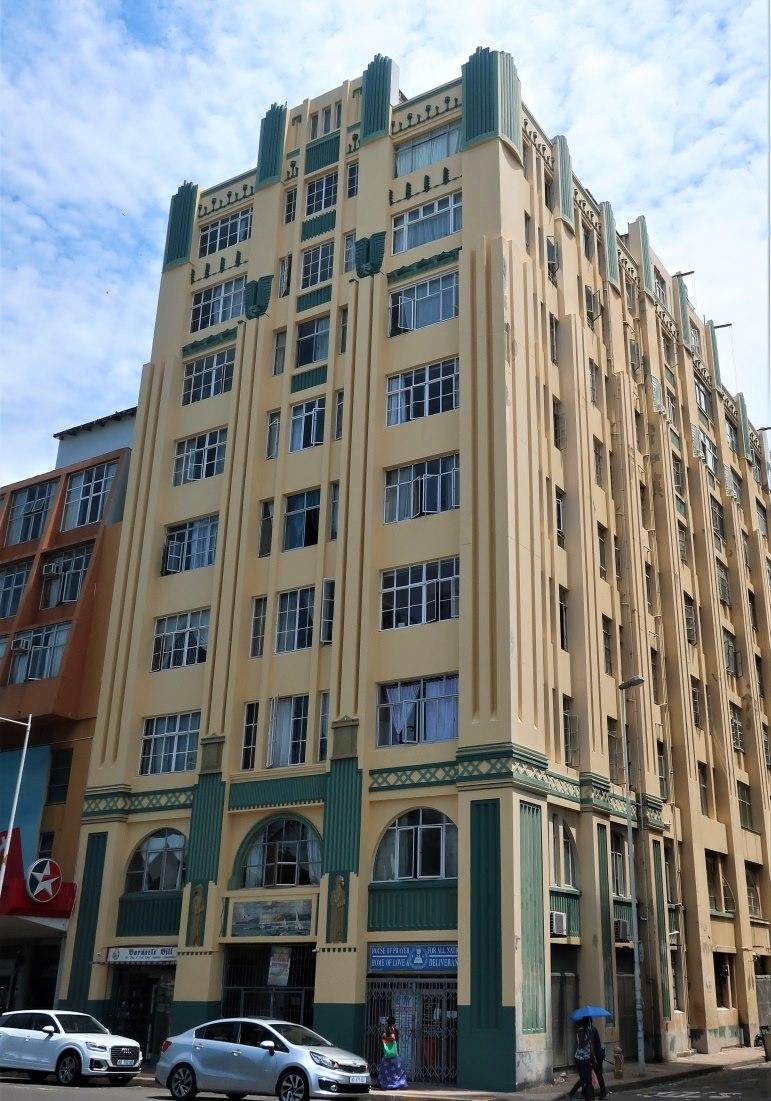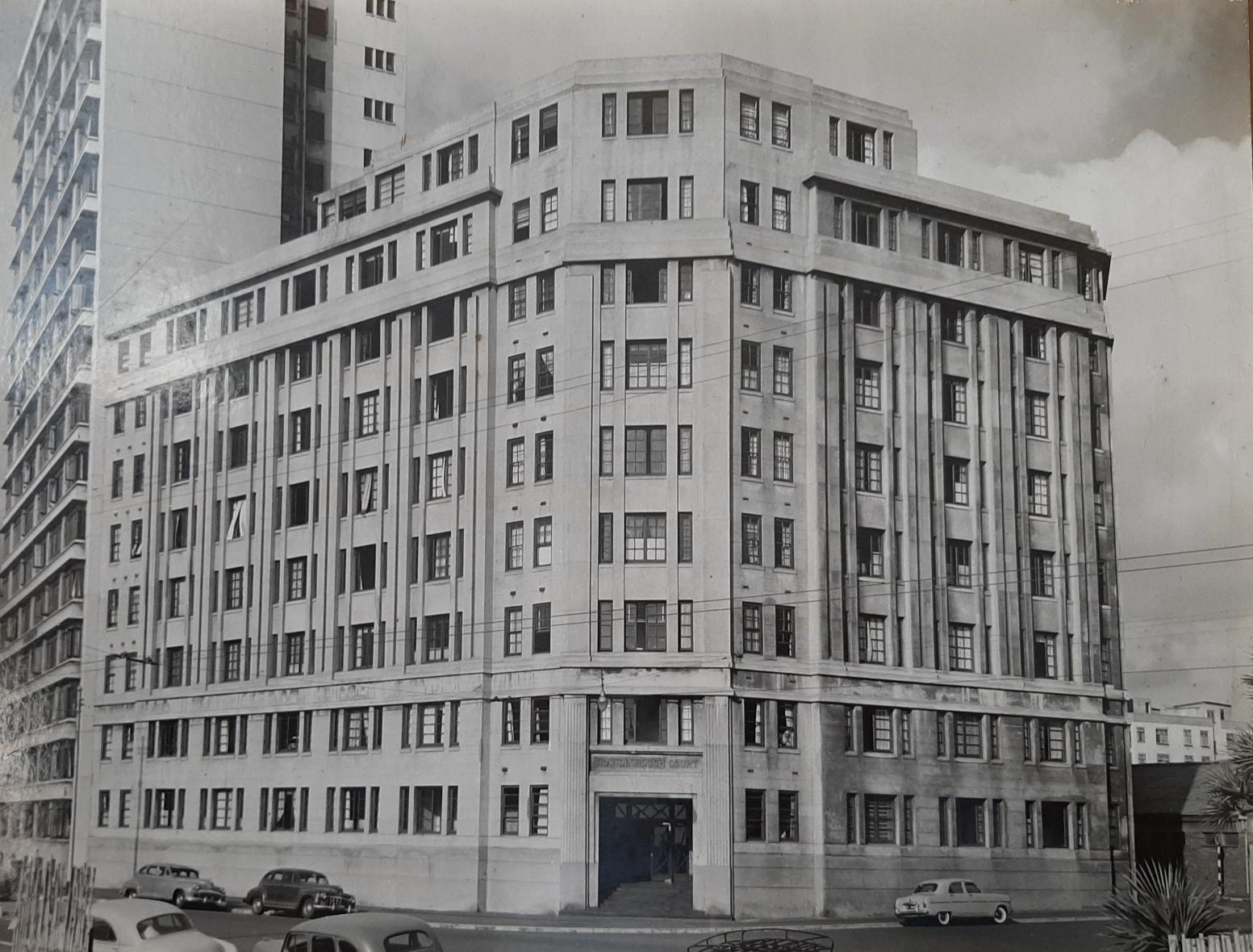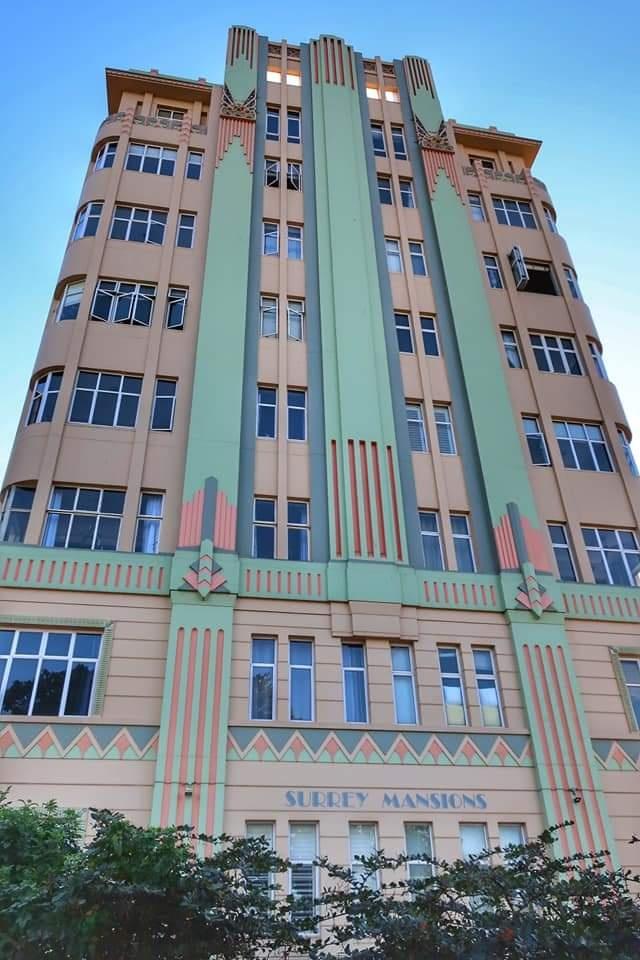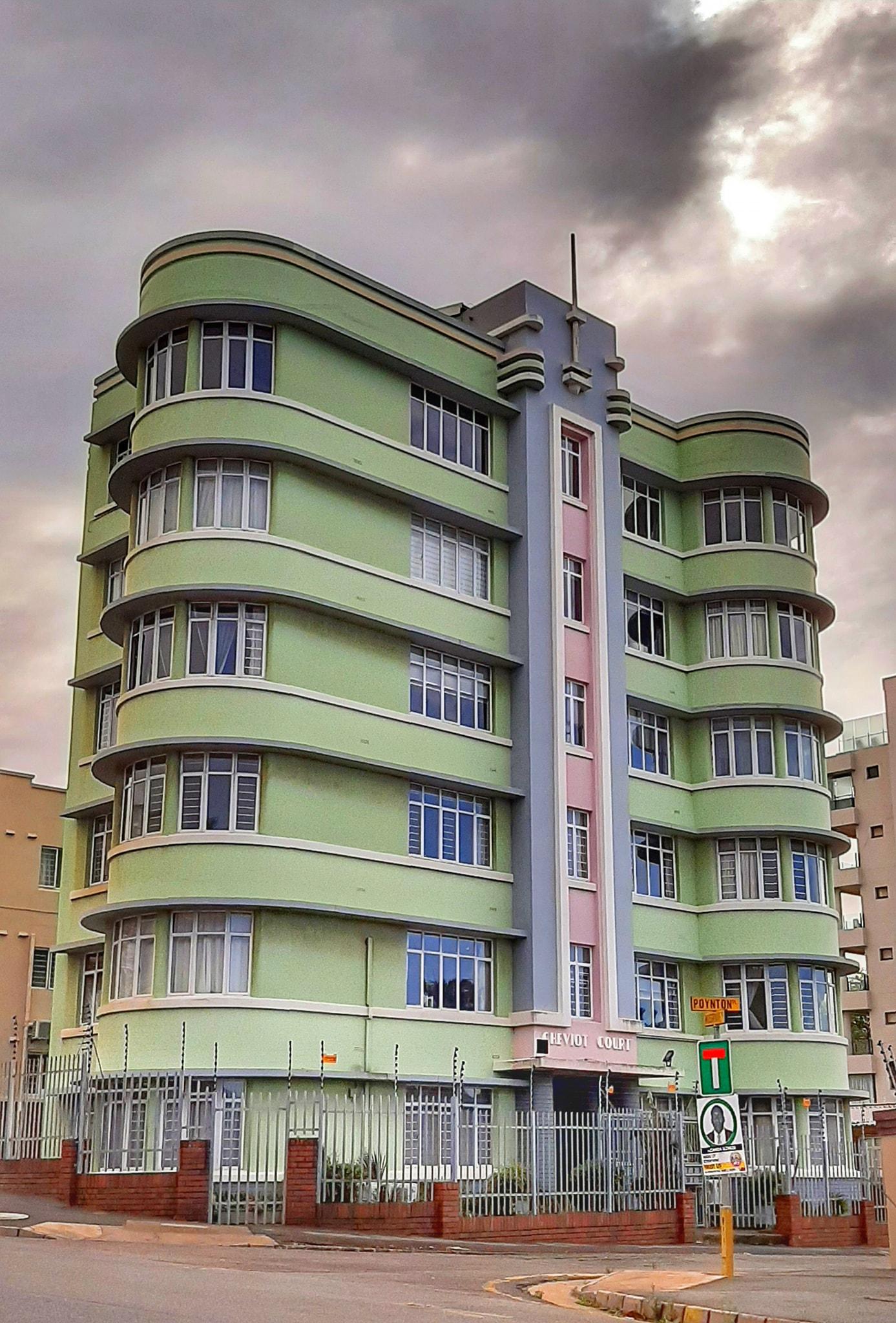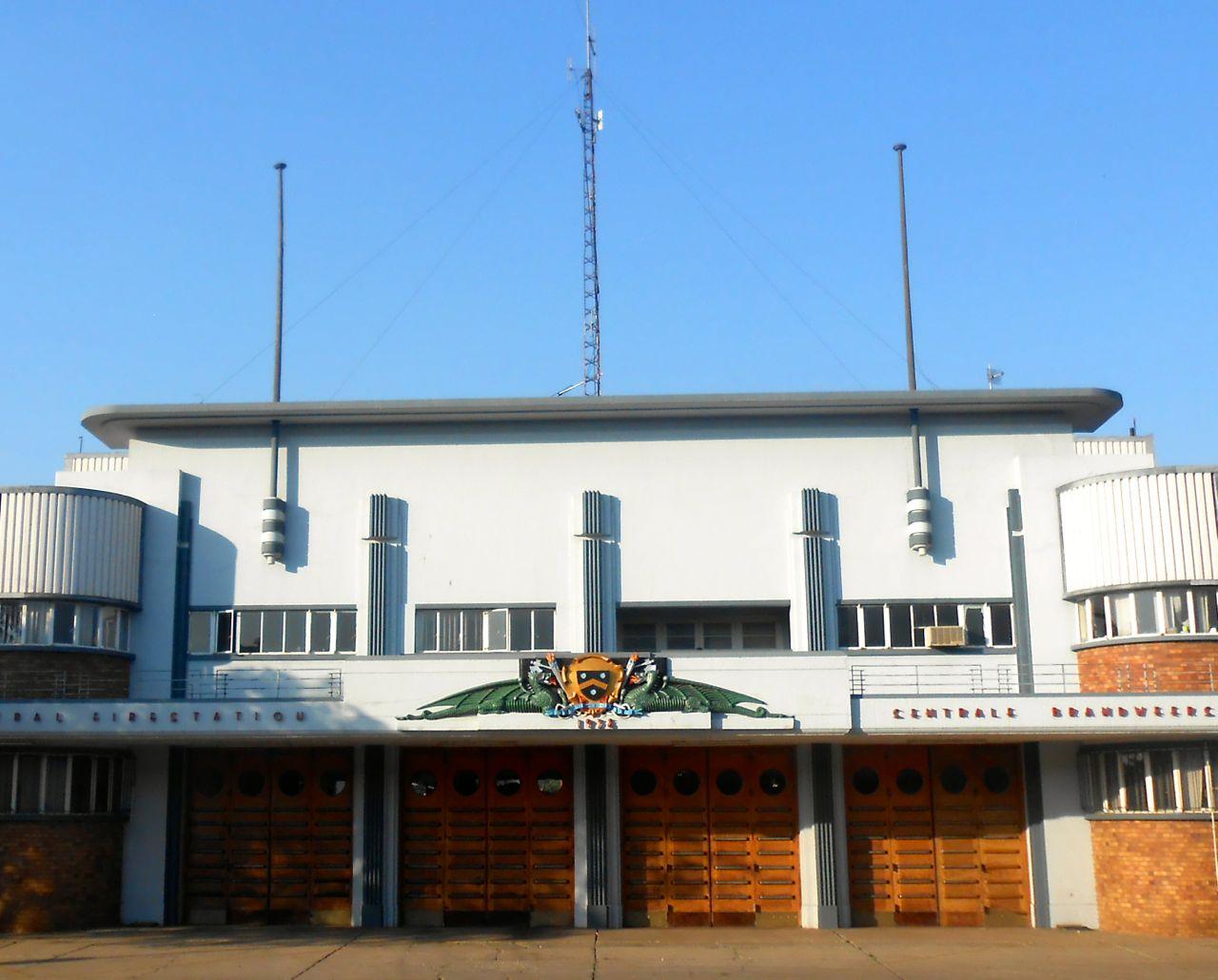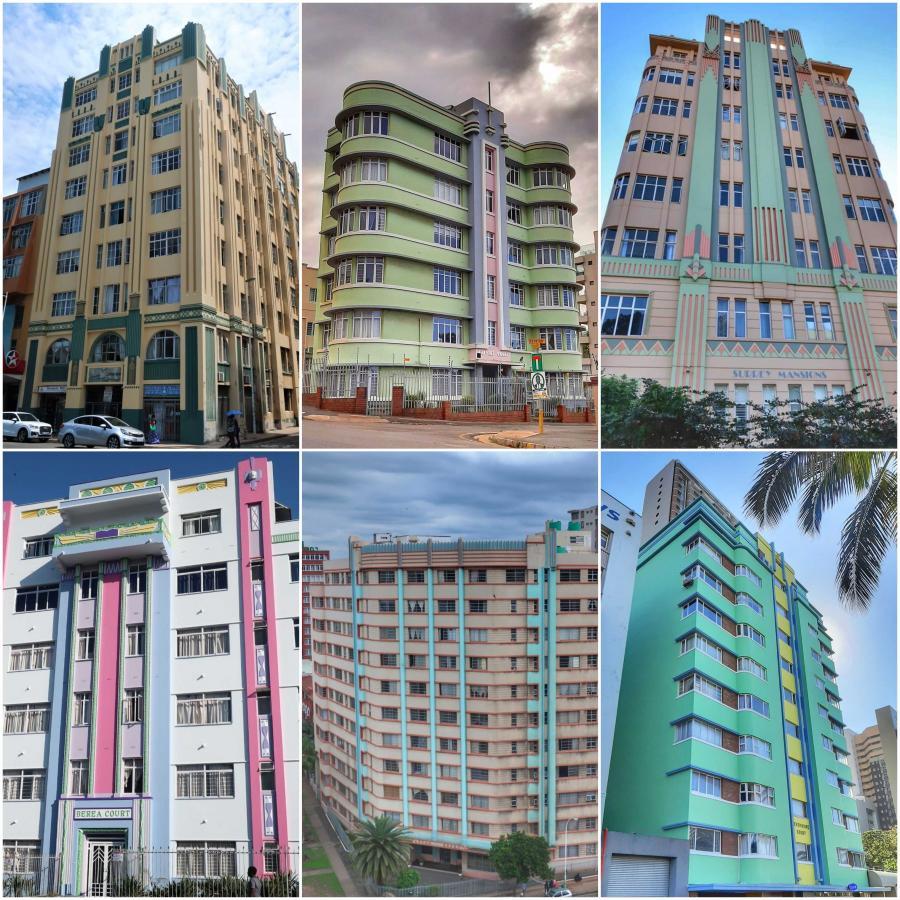
Around the world, Art Deco buildings are celebrated with passion by a range of enthusiasts, architectural historians and aficionados. In Durban, a small but unique society exists to preserve, publicise and promote the Art Deco architecture of the city. The Durban Art Deco Society (DADS) deserves a medal for the work they are doing. This new publication is a cooperative effort of DADS led by an impressive team. The names of people associated with the project are listed under acknowledgements, but perhaps it is Boaz Chaves and Mike Mulholland that did most of the work – there always has to be an editor and coordinator!
Book Cover
It is with some excitement that their book Durban Art Deco: Heritage of a Sub-tropical African City was on sale at the Annual General meeting held on Sunday morning, 21 November 2021 at the Phansi Museum. William Martinson delivered a fitting address on the Art Deco buildings of East London and this had all of us making comparisons to the Durban Deco feast of buildings. We travelled to Durban especially for a weekend of celebration with our Durban Deco friends and to deepen Durban’s association with the Heritage Association of South Africa. We had to leave all too soon to make it back to Joburg by Sunday evening but not before our friend, Durban citizen, Archie Barnwell, insisted on showing us his favourite Deco buildings as we headed back towards the Greyvile Race course - so for me the book immediately inspired an add-on journey and photo opportunity.
The Durban Art Deco Society advises on colour schemes and works with owners of the Art Deco buildings spread across the city, to raise awareness and to make the City Council and its citizens proud of these buildings dating from the 1920s to 1940s. The Society awards certificates recognizing top Art Deco buildings and drives to enhance the understanding and appreciation of this distinctive and rather special architectural period. Their tours have fast established a reputation as high quality - must enjoy – uniquely Durban experiences. Durban Art Deco is worth discovering.
Berea Court (Alison Chadwick)
The book is a hands-on, practical guide to the Art Deco buildings of the City of Durban. It is a brilliant heritage with architect designed apartment blocks, aerodromes, private houses, office blocks, and even the Durban Gordon Pilkington Cenotaph. The book opens with four short accessible chapters on the origins of Art Deco, the historical context, the specifics of Durban’s Art Deco and the motifs and decorations that are characteristic of Art Deco. Here is all you need to know about animal ornamentation, finials, pilasters, roundels, sunbursts and spandrels.
Enterprise building with the eagle motif, adopted by the Durban Art Deco Society for its logo (Kathy Munro)
There are four chapters on the Durban Art Deco buildings to be found in the city centre, on the beachfront, around Grey Street and on the Berea. There is always an excitement when one looks at a façade and the instant recognition hits that this is an Art Deco gem. And part of the fun of the Durban Art Deco trail is finding such treasures for one’s self. This book is the perfect guide to buildings such as Victoria Mansions, Enterprise building, Albany Court and the Cenotaph all in the city.
Victoria Mansions (Alison Chadwick)
The Beachfront along Marine Parade and Snell Parade has Anthea Court, Grandborough Court, Olympic Court, the Edward Hotel, the Suncoast Casino and Towers Hotel and the Stamford Hill Aerodrome. A good friend owned an apartment in Grandborough Court designed by A G Frolich, when he worked for the Obel and Obel practice. I zoomed in on this building because I remember a pleasant week’s stay with my friend about twenty years ago. I would have liked more on Frolich and it raises the question as to who should be given the accolade of architect for a specific building – the design architect, i.e. Frolich or the practice, L T Obel? Of course, what a book of this type does is introduce the range of buildings worthy of documentation and suggest the rabbit burrows for further research and connections.
Old photo of Grandborough Court (Durban Art Deco Society)
Grey Street area is a less salubrious part of the city but it is rich in extraordinary history. It is here that a Hindu temple (the Vedic temple on Carlisle Street) meets the Art Deco style. A full page colour plate, a lovely photo of the front façade entices exploration. Again I found myself with more questions and a hunger for more detail. Empire Court on Grey Street is a mix of shops (on the ground floor) and apartment dwellings on the two upper floors. The dual functionality blends through the use of symmetry, style and motifs. It is a building with a colour scheme of granite grey and pastel lemon that emphasizes the geometric motifs of diamonds, square, circles and horizontal lines.
The Berea is where we find perhaps the finest of Art Deco Durban buildings. The area exhibits such a strong sense of place – a sub-tropical, glamourous city of the thirties. You knew you had arrived if you lived in Surrey Mansions on Currie Road. I agree this is one of Durban’s grandest Art Deco buildings and today it is the building where the Durban Art Deco Society have a small back office and an essential library.
Surrey Mansions (Alison Chadwick)
Cheviot Court on Musgrave Road runs a close second with those rounded corners encountering straight lines - it is Art Deco in motion and recalls that Durban was where you would find the ocean liners, the race horses, the great automobiles such as Pontiacs and Dodges and the palm trees. It is very “Durban”.
Cheviot Court (Alison Chadwick)
One chapter remembers the Art Deco buildings now lost and where we simply have the postcards and the memories. Buildings such as the Natal Building Society headquarters, the Netherlands Bank Enterprise, the Durban and District Co-operative Building, the Lowther Hotel and the Metro Theatre. Then there was Acutt’s Arcade and the Old Mutual and the Westgard House – Trust Building. There are a number of others - now gone forever. The loss of these buildings made me reflect on the demolition and the race to replace what were the latest in modern skyscrapers and substantial office blocks with even more modern and postmodern buildings in the sixties and seventies. As in the case of Escom House in Johannesburg, a fine Deco building demolished in the mid-1980s, it seems that financial institutions far too often race to the next phase and fashion and sacrifice historic beauty in the interests of even higher, technologically more advanced (computer connectivity and air conditioning) alternatives and leave it for the architectural historians to protest, to mourn and then to document the beautiful old buildings that epitomized a period.
Escom House under construction
This book is not an academic study. It is brief and accessible to the lay person and the tourist to shout the message – look about you and find some very special architecture right here in Durban. Here is a city that measures up to Miami in Florida or Napier in New Zealand. My one regret is that there is no attempt to make comparisons with Art Deco buildings in other parts of South Africa - and there are some fine deco survivals in Johannesburg, Springs, Cape Town and even East London. Many of the architects of the period worked throughout the country or would have their principal office in Johannesburg and then a sub-office in Durban.
Central Fire Station, Springs (The Heritage Portal)
There is a useful map pin pointing the Deco buildings featured in chapters 5 to 8. Durban street names have been changed, perhaps more than any other city, so it’s appreciated that both old and new names are given. The efforts made to photograph the buildings featured in large and small colour images is to be commended. The book is a rainbow of Deco colour schemes.
Durban leads the way in this very special celebration of its Art Deco Heritage. The central theme of the book is that Art Deco architecture was “good architecture“ and too often making a judgement call and defining good or bad architecture leads to an indecisive relativism. The Durban Art Deco Society are not afraid to call out quality in the architecture of the interwar period. Stamford Hill Aerodrome is a case in point; erected in 1936 as Durban first modern aerodrome, the building has survived and has been adapted to house the Natal Mounted Rifles regiment.
I strongly recommend this book if you are keen on heritage, Durban or if Art Deco is your thing.
The book is available in Durban from the Society at R250 (plus postage) and from Johannesburg Heritage Foundation (at R270).
Kathy Munro is an Honorary Associate Professor in the School of Architecture and Planning at the University of the Witwatersrand. She enjoyed a long career as an academic and in management at Wits University. She trained as an economic historian. She is an enthusiastic book person and has built her own somewhat eclectic book collection over 40 years. Her interests cover Africana, Johannesburg history, history, art history, travel, business and banking histories. She researches and writes on historical architecture and heritage matters. She is a member of the Board of the Johannesburg Heritage Foundation and is a docent at the Wits Arts Museum. She is currently working on a couple of projects on Johannesburg architects and is researching South African architects, war cemeteries and memorials. Kathy is a member of the online book community the Library thing and recommends this cataloging website and worldwide network as a book lover's haven.

